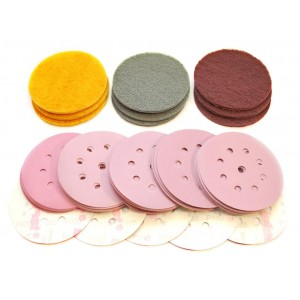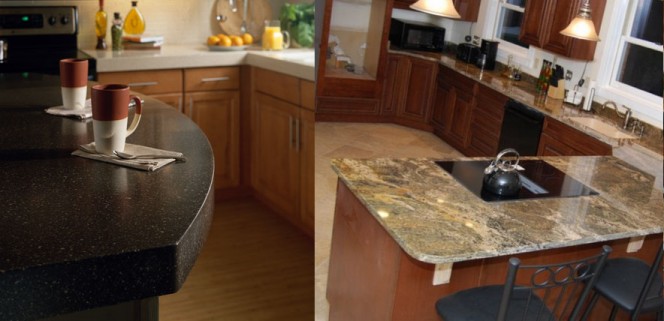Solid surface adhesive dispensing guns have evolved to become an easy to use and essential part of fabricating solid surface. A few years ago the adhesive came in two separate containers. You then had to mix it together in a paper cup with a wooden stick, similar to a doctor’s tongue depressor.
After that you could spread the adhesive mixture onto the solid surface joint with a stick. It was a tedious, time consuming and messy process with plenty of opportunity for mixing ratio errors. If the correct amount of catalyst was added to the base component in the ratio of 10 base to one catalyst, and the temperature in the facility was right, then the adhesive would set (harden) in 20-30 minutes. In this case, the project could move along as planned.
If too much catalyst was added, then the set time would be shorter. However, the challenge in this case is that you wouldn’t be aware of this until it started to set, making it too late to position the components. This would leave you with an excess of gelled adhesive that would have to be removed before the job could go forward.
If too little catalyst was added, the set time would be extended. In this instance you wouldn’t know it until the pieces were in place, forcing you to wait until the adhesive had set. This process could take hours, once again resulting in a project delay.
Adhesive guns have come a long way!
Today, almost every adhesive brand comes in a two cylinder cartridge. The larger cylinder holds 10 times more base component than the smaller cylinder that contains the catalyst. This is where the terminology 10:1 adhesive comes from. [See Photo 1]
Photo 1: Integra Adhesive 10:1 ratio adhesive cartridge and mixing tips.
This delivery design allows for the same ratio of adhesive to be dispensed, cartridge after cartridge. When you pull the adhesive gun trigger, the adhesive in the cartridge is applied directly to the solid surfaces to be joined. This results in a lower risk of project delays due to improper component ratios.
The Top 10 Qualities of New Solid Surface Adhesive Dispensing Guns
Now, let’s consider the top evolutionary qualities of the new solid surface adhesive guns and how they can positively impact the success of your project:
- Possesses a “dripless” feature so when you release the trigger (in order to squeeze the trigger again) the adhesive doesn’t run out.
- Fits 250ml adhesive cartridges from Integra, Sta-Put (Plexus), HI-MACS, Avonite®, Formica®, and Wilsonart® (Gibraltar) and others.
- Has a comfortable padded grip to help prevent hand fatigue.
- Possesses an 18:1 thrust ratio so you can use a moderate controlled hand pressure to make sure the adhesive flows evenly from the tip.
- Has twin precision gripping plates that carefully control the advancement of the pistons.
- Contains a “wear adjustment” screw to keep the gripping plates configured properly.
- Capable of dispensing high-viscosity solid surface adhesive.
- Has a thumb-activated rear lever to instantly stop dispensing when completed.
- Contains extra durable, heat-treated piston push-rods that resist wear and misuse.
- The durable cartridge cage is made of steel for long life.
How do these top 10 qualities fit into the task of seaming solid surface?
Lets take a look at the actual steps that promote a good bond and successful project:
- First, cut and position the solid surface components so they are ready for the application of adhesive. (It also helps if the material is allowed to reach the temperature of 60 degrees or warmer.) [See Photo 2]
Photo 2: Prepare the material and tooling.
- Place the cartridge in the gun and pull the trigger to position the gun pistons correctly behind the cartridge.
- Open the cartridge, and hold the gun at an upward slant with a paper cup under the cartridge openings. Pull the trigger so a small amount of materials are dispensed from both cylinders of the cartridge. (Make sure you see material flowing from both cylinders.)
- Place the mixing tip in place and tighten the retaining nut to hold it there.
- Pull the trigger so that adhesive flows through the mixing tip and onto a scrap piece of cardboard or into the cup. Dispense a blob about the size of a quarter to make sure it is flowing properly. [See Photo 3]
Photo 3: Purge a small amount of adhesive to ensure a good mix.
- Apply the adhesive to the materials to be joined. Lay down the bead of adhesive by pulling the gun tip toward you. [See Photo 4]
Photo 4: Apply a 1/4″ bead of adhesive.
- Infrequently, an air bubble that is trapped in the catalyst part of the adhesive is released into the mixing tube and the air (instead of catalyst) mixes in with the base component. As a result, this portion of the bead will lack the catalyst and will not cure or set. To prevent this from happening, add a second bead of adhesive to ensure that catalyst is available to all areas of the adhesive bead. It’s unlikely that air bubbles will occur at exactly the same point twice. (TIP: storing the cartridge in an upright position allows air bubbles to rise to the top and be expelled during the initial dispensing of material from the cartridge that is mentioned above)
- Clamp the pieces together, let the adhesive set, and move on to the next steps for completing your project. [See Photo 5]
Photo 5: Clamp the pieces together.
As you can see, the new adhesive guns have been optimized to make your solid surface projects easier and more effective. Here’s wishing you every success(!) and be sure to also visit our instructional guides for working with solid surface for more in-depth instruction.



